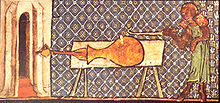- Walter de Milemete
-
Walter de Milemete was an English scholar[1] who wrote a treatise on Kingship for the young prince Edward, later king Edward III of England called De nobilitatibus, sapientiis, et prudentiis regum in 1326.[2] The Treatise includes images of siege weapons and what is probably the first[3] illustration of a firearm: a pot-de-fer.[4] One of the marginal border illustrations in the Milemete Treatise shows a soldier firing a large vase-shaped cannon, the arrow-shaped projectile is seen projecting from the canon which is pointed at a fortification.[5] In the 1331 siege of Cividale, German knights used guns which were probably very similar to Milemete weapons.[6]
References
- ^ M.A. Michael. 'The iconography of kingship in the Walter of Milemete treatise'. Journal of the Warburg and Courtauld Institutes, 57 (1994), 35-47.
- ^ C.J. Nederman, Political thought in early fourteenth-century England : treatises by Walter of Milemete, William of Pagula, and William of Ockham, Turnhout, 2002.
- ^ Anne Curry, in The Hundred Years' War, 1337-1453 ISBN 1-84176-269-5 includes a drawing from a book of instruction for Edward III of England which "may predate slightly [Milimete's illustration]"
- ^ Walter de Milemet from Science and Its Times (2006)
- ^ Montague Rhodes James, ed., The Treatise of Walter de Milemete, 1913, p. 140, cited in Robert Douglas Smith, The Artillery of the Dukes of Burgundy, 1363-1477, p. 10 ISBN 9781843831624
- ^ Rogers, Clifford J., Military Revolutions of the Hundred Years' War, in The Military Revolution Debate, p. 65. ISBN 0-8133-2054-2
Categories:- English military writers
- Siege warfare
- Warfare of the Middle Ages
Wikimedia Foundation. 2010.

